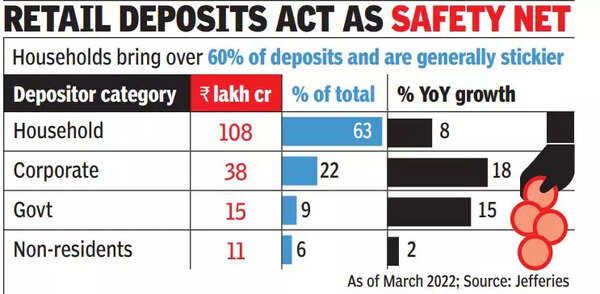Rbi: RBI reviews bond value norms that shield banks – Times of India
According to banking sources, the RBI has informally sought feedback on what would happen if the dispensation were lifted and lenders were required to show mark-to-market (MTM) losses in their bond portfolio. Typically, MTM losses are on paper, and derived from current market value rather than sale value. Bond prices and interest rates have an inverse relation, and any increase in interest rate results in the bond prices falling to adjust the yield to the prevailing interest rates.

Banks invest around a fifth of their deposits in government bonds. However, they can avoid making MTM provisions on the bonds they classify as ‘held to maturity’ (HTM). However, banks have to provide for a fall in the market value of bonds in their trading or ‘available for sale’ portfolio.
Doing away with the HTM category would force banks to manage interest rate risks better. A corollary impact would be a more vibrant bond market.
Currently, banks have a higher limit for the HTM category of 23% of deposits (as against 19% earlier) per a special dispensation allowed by the RBI during Covid. In December, the RBI extended this dispensation up to March 2024 but said the HTM limits would be restored from 23% to 19.5% in a phased manner from June 2024.
In March 2023, the Silicon Valley Bank collapsed as it had MTM losses of $15.1 billion and a net worth of just $16 billion. Since then, analysts have been looking at banks’ bond profiles. In a report after the collapse, Jefferies said that the impact of MTM loss on the HTM portfolio is 6% of net worth for private banks in India and 15% for public sector banks.
According to the report, over 60% of deposits are households. The balances in savings deposits are stickier. Bankers say that the HTM category is justified as the current and savings account pool is stable, and the cost of funds of money lying in these accounts does not rise.
However, recent experience shows that sharp interest rates nudge depositors to move balances from savings accounts to fixed deposits. Also, there have been instances when banks have come out with disruptive rates for savings accounts. Most large multinational banks avoid taking shelter under the HTM category to avoid making losses if the securities are to be sold in an emergency. Some bankers say it should be left to bank boards to decide on the ideal level of HTM.
function loadGtagEvents(isGoogleCampaignActive) { if (!isGoogleCampaignActive) { return; } var id = document.getElementById('toi-plus-google-campaign'); if (id) { return; } (function(f, b, e, v, n, t, s) { t = b.createElement(e); t.async = !0; t.defer = !0; t.src = v; t.id = 'toi-plus-google-campaign'; s = b.getElementsByTagName(e)[0]; s.parentNode.insertBefore(t, s); })(f, b, e, 'https://www.googletagmanager.com/gtag/js?id=AW-877820074', n, t, s); };
window.TimesApps = window.TimesApps || {}; var TimesApps = window.TimesApps; TimesApps.toiPlusEvents = function(config) { var isConfigAvailable = "toiplus_site_settings" in f && "isFBCampaignActive" in f.toiplus_site_settings && "isGoogleCampaignActive" in f.toiplus_site_settings; var isPrimeUser = window.isPrime; if (isConfigAvailable && !isPrimeUser) { loadGtagEvents(f.toiplus_site_settings.isGoogleCampaignActive); loadFBEvents(f.toiplus_site_settings.isFBCampaignActive); } else { var JarvisUrl="https://jarvis.indiatimes.com/v1/feeds/toi_plus/site_settings/643526e21443833f0c454615?db_env=published"; window.getFromClient(JarvisUrl, function(config){ if (config) { loadGtagEvents(config?.isGoogleCampaignActive); loadFBEvents(config?.isFBCampaignActive); } }) } }; })( window, document, 'script', );
For all the latest business News Click Here

